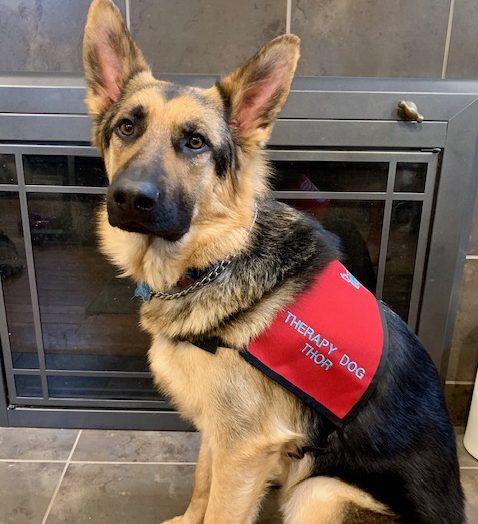By Thomas Belasco
After attending the School Resiliency Team training with Dr. Lori Desautels and Michael McKnight, I returned to school excited to spread the word and develop a platform for working with those children in the direst need of positive reinforcement. It did not take long to realize that as important as it is to address the needs of children, to be successful we must first meet the needs of those who work with them.
Whether we work in a classroom, an office, a school bus or a cafeteria, we all bring an array of stress, anxiety and in some cases, downright panic with us every day. Until we come to terms with our own stress and frustration, it grows more challenging to help others cope with theirs.
This came together at a somewhat perfect time in my life, as I am currently in a meditation and mindfulness teacher certification program. I began looking at many of our practices in this program and worked on modifying them to be more applicable in the classroom and in techniques that could be implemented quickly between periods.
All of these practices not only serve to ground us as individuals, but additionally help us to guide our students in a calmer, focused and deliberate manner. Each morning when I come into the classroom, I read to myself a quote from Haim Ginott that I have laminated and taped to my desk:
“I’ve come to the frightening conclusion that I am the decisive element in the classroom. It’s my personal approach that creates the climate. It’s my daily mood that makes the weather. As a teacher, I possess a tremendous power to make a child’s life miserable or joyous. I can be a tool of torture or an instrument of inspiration. I can humiliate or heal. In all situations, it is my response that decides whether a crisis will be escalated or de-escalated, and a child humanized or dehumanized.”
While these techniques help us to regulate ourselves, they ultimately allow us to serve as a thermostat, rather than a thermometer, for the mood of the classroom and de-escalate tense situations rather than making them worse.
As I explore the idea of mindfulness and mindfulness-based stress reduction, I will first explore here the science and documented proof behind these practices and present methods teachers can put into practice immediately in the classroom, between periods, and ideally, throughout our lives.
The benefits of mindfulness
Thankfully, we are looking at mindful practices in a time in which much scientific exploration has been applied to these techniques. In her 2014 paper, “Evidence for Mindfulness: Impacts on the Well-Being and Performance of School Staff,” Katherine Weare reports that educators who study mindfulness and put it practice:
• Tend to experience fewer mental health problems such as stress, depression and anxiety.
• Report greater well-being, including a sense of calmness, life satisfaction, self-confidence, and self-compassion.
• Tend to have better physical health, including lower blood pressure, declines in cortisol (a stress hormone) and fewer reported physical health problems and days off work.
Additionally, in her book, Assessing Mindfulness and Acceptance Processes in Clients, Ruth Baer, Ph.D. documents meditation’s ability to activate regions of the brain that regulate emotion, attention and cognition, as well as alleviate stress and anxiety. Coming from a basis in research, the reminder of this article will present some methods you can use to initiate a practice both in your classroom and develop a simple practice at home.
Breathing techniques
The first step in developing a mindfulness practice is to work on breathing.
Americans have a tendency to take shallow breaths that tend to increase the body’s reaction to stressors, rather than reducing the stress. A good first step is to cultivate deep breaths that expand the belly. The term often used in mindfulness practice is a Buddha Belly.
One way to practice this at home is to lie on your back with a pillow or stuffed animal on your stomach. As you breathe, the pillow/stuffed animal should move up and down. Belly breathing has concrete benefits. When you find yourself in a stressful situation, such as a child’s outburst or an administrator’s classroom observation, simply taking two to three minutes to take slow deliberate breaths into your belly and fully exhaling can cause the body to slow down and relax.
A variation on this technique that helps to clear your mind and guide your focus is a YouTube video titled “Relax and Breathe: Do Nothing for Ten Minutes.” This video features an expanding and contracting shape and light music that you can use to accompany your breathing. The shape guides the pace of your breathing, which allows your nervous system to slowly calm down and come back to center. To find it, go to youtube.com and search for the title of the video.
Two more variations on this breathing technique include counting your breaths or reciting a phrase as you breathe in and breathe out. Simply take a stomach-expanding breath. As you exhale, say the number one. Continue this technique counting to 10. If you find yourself distracted and thoughts begin to pull you away, begin again at one and see if you can get to 10.
In reciting a phrase, you simply replace counting with helpful words. I tend to use the phrase “Breathing in calm, breathing out stress.” Another phrase that works well comes from the Vietnamese Buddhist monk Thich Nhat Hanh: “Breathing in, I calm myself. Breathing out, I feel at ease. Breathing in, I smile. Breathing out, I release. Breathing in, I dwell in the present moment. Breathing out, I feel it is a wonderful moment.”
In all of these breathing activities, it is helpful to close your eyes; but if that makes you uncomfortable, simply soften your gaze upon a place on the floor approximately a foot in front of you.
Another breathing method that I like to use in high stress situations came to me from Brené Brown. It is called foursquare breathing. I breathe in counting to four and hold my breath for another four counts. Then I breathe out for four counts and hold air out of my lungs for four counts. Through the course of the exercise, I draw a square with my finger. Each side of the square represents a step in the exercise: breathing in, holding my breath, breathing out, and holding my breath. Between class periods, I will do three of these sets of this exercise to clear out what happened the period before and bring me back to the present moment.
Two other practices come in especially handy in high stress moments or times you can feel panic surfacing. They serve to take your mind off the past and bring you squarely into the present moment.
The first activity is a sensory breathing activity invoking all five of your senses.
1. As you slow your breath, look around and silently name five things you can see.
2. As you continue to relax your breath, listen for four things you can hear and name them.
3. Continue the process with three things you can touch; I keep quite a few textured objects on my desk.
4. Now, as you slowly breathe, find two things you can smell
5. Lastly, identify one thing you can taste. I always tell those with whom I work that you can simply taste your tongue; nevertheless, this is a great reason to keep chocolate or mints in your room.
This takes a you out of your head and brings you calmly you into the present moment.
Intentional walking
The second practice is a walking meditation. Once again, you slow your breathing to a deliberate and calm pace. Continue with a consciously slow pace focusing on how your feet come into contact with the ground, the firmness of the floor beneath you and how one foot lifts as the other foot begins to plant itself.
As you perform this intentional walking, soften your gaze about two feet in front of you looking toward the floor. I do not make eye contact with others in the hall as I am trying to direct my mind inward. I would try to undertake a walk of at least 40 steps, but do not get fixated on counting your steps. Additionally, afterward, it is helpful to let your colleagues know what you are doing so they don’t just feel you are being rude when you do not say hello. I learned this while conducting a workshop, and teachers mentioned that they thought it was strange when I did not acknowledge them.
The significance of mental grounding brought through mindfulness practices can be seen through its use in the military, on police forces, by professional athletes and beyond. Bestselling author and historian Yuval Noah Harari, Sapiens and 21 Lessons for the 21st Century writes:
“Two things, mainly. First of all, it’s the ability to focus. When you train the mind to focus on something like the breath, it also gives you the discipline to focus on much bigger things and to really tell the difference between what’s important and everything else… It’s so difficult to keep reminding yourself what is really the most important thing that has happened in history or what is the most important thing that is happening now in the world. The discipline to have this focus I really got from the meditation. The other major contribution… is to learn the difference between fiction and reality, what is real and what is just stories that we invent and construct in our own minds. Almost 99% you realize is just stories in our minds.”
The ability to focus and to separate fiction from reality serve teachers well. Improving our focus allows us to be more efficient and productive both in the classroom and through our grading and preparation. Seeing the difference between what is real and what we have created in our minds through worry and perception helps to alleviate the vast majority of our stressors.
Finally, I emphasize that while these are wonderful practices in our classroom, developing a practice throughout your life will provide enormous benefits. Something as simple as 10 to 15 minutes in the morning or evening provides a grounding time that you can tap into throughout the day.
While having a teacher-led group practice is ideal, many of us do not live in an area where that is possible. In those cases, some of the smartphone apps serve to augment the practice. Three that I have used and find particularly helpful are Calm, Headspace, and Ten Percent Happier, created by Dan Harris of “Good Morning America.” These three apps require a subscription fee, although Calm and Headspace have offered free subscriptions for teachers from time to time. Insight timer is an app that provides free material.
Whatever method you choose, making your practice a daily habit is key. It does not have to be for a long period of time, 10 -15 minutes a day can bring about substantial changes. Make the time to invest in yourself. You are worth it, and your students will benefit from it.
Thomas Belasco is an English teacher at Lower Cape May Regional High School. He is the 2019-20 Cape May County Teacher of the Year. Belasco is currently in a meditation and mindfulness teacher certification program through practitioners Tara Brach and Jack Kornfield. He can be reached at tjbelasco@gmail.com.



